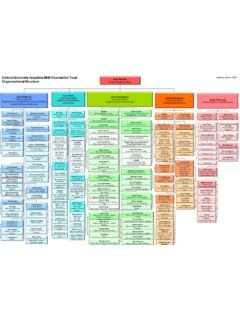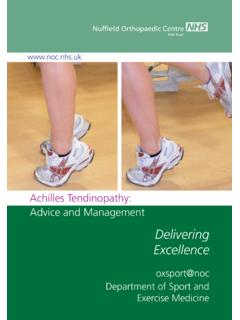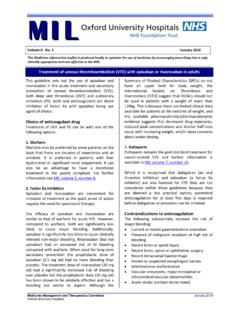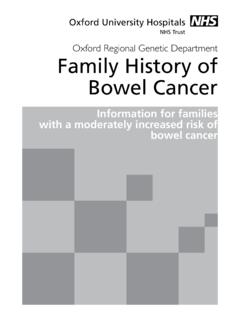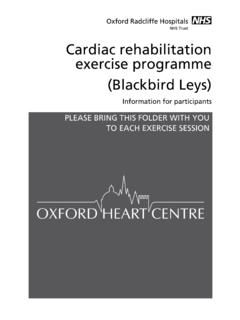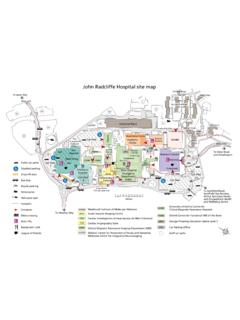Transcription of INFORMATION FOR YOU Frozen Shoulder
1 Frozen SHOULDERFROZEN SHOULDERINFORMATION FOR YOU Frozen ShoulderOXFORDSHOULDER & ELBOW CLINICWhat is Frozen Shoulder ?Typically the joint is stiff and initially painful, often starting without an apparentcause. The loose bag (capsule) around the Shoulder joint becomes inflamed. The bagthen appears to tighten or shrink. This tightening combined with the painrestricts the common is it?It is most common in people between the ages of 40 and 70 years and hasbeen estimated to affect at least one person in 50 every aim of this INFORMATION sheet is to give you some understanding of theproblem you may have with your Shoulder . It has been divided into sections,describing your Shoulder , what we know about Frozen Shoulder and yourtreatment your shoulderThe Shoulder is designed to have a large amount of movement so that we canuse our hands/arms in a wide variety of positions. Some movement occursbetween the Shoulder blade and chest wall.
2 However most Shoulder movementsare at the ball and socket ball at the top of the arm bone ( humerus ) fits into the shallow socket( glenoid ) which is part of your Shoulder blade ( scapula ). There is a loose bagor capsule which surrounds the joint. This is supported by ligaments and Shoulder (viewed from front) Frozen SHOULDER2 PAGEFROZEN SHOULDERB onesCapsuleArm boneSocketShoulderbladeCapsuleA staggering one million people in the UK will have Frozen Shoulder in a 10% of people may develop Frozen Shoulder in the other Shoulder within 5 7 years of the first one. However it tends to resolve more quickly than the it is widespread, it is a difficult condition to treat. We hope that thisinformation sheet will help to explain what we know about it so does it occur?A primary Frozen shoulderis when the exact cause is not known. It is morecommon in people with diabetes and with a thyroid gland problem.
3 About 15%of patients link it to a minor injury to the Shoulder . A secondary Frozen shouldercan develop if the Shoulder area is kept still for sometime, for example, after a stroke or heart attack. It can also occur after majorinjury or surgery to the Shoulder . Some experts think the inflammation starts with a problem in the Shoulder itself,others feel it is related to factors away from the Shoulder ( stiff neck, certaindiseases).Research is continuing to try and answer some of these tests may be done?The main way we diagnose the problem with your Shoulder is from what youtell us and from our examination. Sometimes an X ray will be done to checkthere are no bone changes in your Shoulder is likely to happen?There are 3 main phases 1) Painful phase (which can last from 2 to 9 months)The pain often starts gradually and builds up. It may be felt on the outside ofthe upper arm and can extend down to the elbow and even into the forearm.
4 It can be present at rest and is worse on movements of the arm. Sleep is oftenaffected, as lying on it is painful or impossible. During this time movements ofthe Shoulder begin to be ) Stiff phase (which can last from 4 to 12 months)The ball and socket joint becomes increasingly stiff, particularly on twistingmovements such as trying to put your hand behind your back or head. Thesemovements remain tight even when you try to move the Shoulder with yourother hand or someone tries to move the Shoulder for is the ball and socket joint which is stiff. The Shoulder blade is still free tomove around the chest wall, and you may become more aware of ) Recovery phase (which can last from 5 to 26 months)The pain and stiffness starts to resolve during this phase, and you can begin to use your arm in a more normal total duration of the process is from 12 to 42 months, on average lasting 30 SHOULDERFROZEN SHOULDER4 PAGEFROZEN SHOULDERIt is important to realise that although the pain and stiffness can be very severe,usually the problem does resolve.
5 It will not bother you for ever!This operation is notdone routinely for Frozen Shoulder , only for those whichare very slow to review of people who had Frozen Shoulder approximately 7 years earlier showsthat only 11% still had mild interference with everyday activities. However, 60%continued to have some stiffness in the Shoulder joint when it was measured. So ultimately, it should have little effect on your daily life, although the jointmay remain stiffer when are your treatment options?There is no one agreed treatment option that has beenshown to work. Ultimately the Shoulder appears to go through the threephases described and no treatment has altered thispattern. The passage of time is the main treatment!During the painful phasethe emphasis is on pain-killing tabletsand anti-inflammatorytablets may be can also try using heat, such as a hot water bottle,or cold (ice packs).Injectionsinto the joint may also be offered if the paincontinues.
6 Physiotherapyat this stage is directed at pain-relief (heat, cold and other pain relieving modalities suchas electrotherapy). Forcing the joint to move can make itmore painful and is best notpursued. You can try using a TENS machine(transcutaneous nerve stimulation) which some people find helpful or try alternative therapies such as stiffness is more of a problemthan pain, physiotherapyis indicated. Youwill be shown specific exercises to try and get the ball and socket moving. Someof these are shown at the end of this leaflet. In addition, the therapist may movethe joint for you, trying to regain the normal glides and rolling of the are known as joint mobilisations. Muscle based movement techniquesmay also be movement is not changing with these measures, physiotherapy will bediscontinued, although it is appropriate to continue with the suggestedexercises to try and maintain the movement that you , as the recovery phase starts you will find that the movementgradually increases.
7 This, again, can be a useful time to have physiotherapy tohelp maximise the movement. SurgeryIf you have significant pain and stiffness the doctors may offer you a Manipulation under Anaesthetic (MUA) plus arthroscopy operation. There is aseparate INFORMATION leaflet on this. It involves a distension procedure whichtries to stretch the loose bag (which is now tight) around the Shoulder joint. The tight capsule may be released or removed. In addition the joint is stretchedin certain directions to try and free the joint up. 5 PAGEFROZEN SHOULDERE xercisesThese are some examples of exercises to stretchyour Shoulder . They may bechanged for your particular exercises regularly 1 2 times a day. You may find them easier to do after a hot shower or bath. Using a hot water bottle is another is normal for you to feel aching or stretching sensations when doing theseexercises. However severe and lasting pain ( more than 30 minutes) is notrecommended.
8 Reduce the exercises by doing them less often or less the pain is still severe discontinue the exercises and see the physiotherapist or note: Raising your arm forwards often improves first. Getting your handbehind your low back appears to be the last movement to return. Do not dothese movements if they are painful rather than stiff.* exercises shown for right Shoulder unless PendulumLean forwards with support(shown for left Shoulder ) Let arm hang down Swing arm forwards and back side to side around in circles (both ways) Repeat 5 10 times each movement Keep elbow into your side throughout Push with unaffected arm so hand ofproblem side is moving away from themid-line (can be done lying down) Do not let your body twist round tocompensate Repeat 5 10 times2. Twisting outwardsSitting holding a stick (rolling pin, umbrella) Frozen SHOULDER6 PAGEFROZEN Shoulder Support problem arm with otherhand at wrist and lift it up overhead Do not let your back arch Can start with elbows bent Repeat 5 10 times3.
9 Arm overheadLying on your back (shown for left Shoulder ) Place hands behind neck orhead, elbows up to ceiling Let elbows fall outwards Repeat 5 10 times4. Twisting outwards/arm overheadLying on your back, knees bent and feet flat 5. Kneeling on all foursKeep your hands still Gently sit back towardsyour heels To progress take yourknees further away fromyour hands Repeat 5 10 times7 PAGEFROZEN SHOULDER6. Sit or stand Try and set up a pulley system withthe pulley or ring high above you. Pulldown with your better arm to help liftthe stiff arm up Repeat 10 times7. Stretching the back of the Shoulder (shown for left Shoulder )8. Hand behind backStanding with arms by side Take hand of your problem shoulderacross body towards opposite Shoulder Give gentle stretch by pulling with youruninvolved arm at the elbow Sometimes you can feel more stretch ifyou lie on your back to do the movement Repeat 5 times, holding for 20 seconds Grasp wrist of problem arm and; gently stretch hand towards youropposite buttock slide your arm up your back Can progress and use a towel Repeat 5 timesRemember this is oftenthe last movement toreturn do notforce ifpainful, rather than stiffNB.
10 Normally it is best to have thefixed pulley point behind leaflet has been written to help you understand more about the problemwith your Shoulder . This leaflet is not a substitute for professional medical adviceand should be used in conjunction with verbal INFORMATION and treatment given at the Nuffield Orthopaedic will be gratefully received. Please send to jane Moser, SuperintendentPhysiotherapist, Oxford Shoulder & Elbow Clinic, Nuffield Orthopaedic CentreNHS Trust, Oxford, OX3 7LD or give in at a clinic


